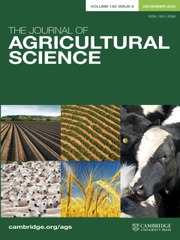No CrossRef data available.
Article contents
The potential application of Illumina MiSeq sequencing in herbivore-diet analysis: quantitative estimation of sheep diet in meadow steppe
Published online by Cambridge University Press: 18 March 2025
Abstract
DNA barcoding approaches have been successfully applied for estimating diet composition. However, an accurate quantification in the diets of herbivores remains to be achieved. In the current study, we present a novel methodology that reveals the relationship between the actual proportions (by mass) of each herbage species in the diets and the relative proportions of the ITS2 gene sequences obtained from faecal samples to evaluate the diet composition of sheep in a meadow steppe. Nine common and 12 rare species of plants were employed for formulating 6 diets, along with the addition of feed supplements for improving the growth performance of sheep. Faecal samples were collected for DNA analysis over the period spanning days 7–12. A significant positive correlation (Spearman’s ρ = 0.389) was obtained between the actual proportions (by mass) of the herbage in the diet provided and the relative abundance of ITS2 sequences obtained from the faecal samples. A significant regression coefficient was found between the relative abundance of all common species and their respective herbage mass proportions. The accuracy of the relation equations, evaluated by utilizing the similarity coefficient, showed 84.69% similarity between the actual diet composition and the correct percentage. Taken together, the current study has provided empirical evidence for the accuracy and applicability of ITS2 as a DNA barcode for obtaining quantitative information about the diet composition of sheep grazing in species-rich grasslands.
- Type
- Animal Research Paper
- Information
- Copyright
- © The Author(s), 2025. Published by Cambridge University Press



